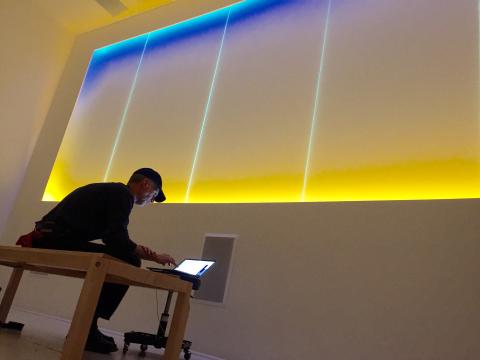Hundreds of seismic stations send data continuously to our lab from places scattered across Alaska. We are mainly concerned with earthquakes, but this data captures everything that shakes the ground, from landslides and calving glaciers to the activities of humans and wildlife. If you have ever walked near enough to one of our stations—say, on Anvil Mountain in Nome or on Porcupine Dome in the White Mountains—then a recording of your footsteps exists somewhere in the terabytes of archived data.
Taken together, all of these data streams represent a sort of EKG of the Earth. They show distant and local earthquakes, movements of magma through the crust, and the energy of ocean swells transferred to the land. Considered alone, each data stream is like a journal of the place where its station sits, showing vibrations from distant sources along with the ambient noise of the local environment: roots of swaying trees, a nearby river, a herd of caribou.
We share this data with partners who use it for everything from pure research to tsunami warning to monitoring critical faciltiies such as dams and pipelines. Our most unusual partnership, though, is with composer John Luther Adams, who turns our data into music.
Adams, who lived in Alaska from 1978 until 2014 and still keeps a studio here, is a Pulitzer Prize-winning composer known for experimental music with a deep sense of place. The Place Where You Go to Listen, which opened at the UA Museum of the North in 2006, was a new kind of piece for Adams—or for anyone—an always-running, unrecorded sound installation described by the New Yorker as an “infinite musical work that is controlled by natural events occurring in real time.”
Inside The Place Where You Go to Listen, sounds associated with different natural events create musical layers that change with conditions outside. Predictable patterns, such as the position of the sun and the phases of the moon, play against unpredictable phenomena such as earthquakes, weather, and the aurora. These originate as raw data streams from different kinds of monitoring stations across Interior Alaska, including our seismic stations. Seismicity can be heard in the music, or felt, as anything from a subsonic rumble to sounds that are more like drums.
The Place Where You Go to Listen, now ten years old, has just reopened after closing for upgrades including new speakers, signs, and the addition of sounds linked to wind speeds. The seismic data has been slightly tweaked as well, with two new stations added to better represent the variety and scope of Interior Alaska. In all, Adams uses seismic data from five stations:
CCB is at Clear Creek Butte, off the Bonnifield Trail on the Tanana Flats. This is a new addition to The Place Where You Go to Listen, and the only station visible from the museum. Looking south, Clear Creek Butte is about ten miles beyond the airport.
COLD, just south of Coldfoot Camp, is the only Arctic station in the mix. Our network is thin in the northern part of the state, so station COLD singularly captures much of the Brooks Range.
KTH, in the hills above Kantishna in Denali National Park, records subduction movements deep below Denali as well as the enigmatic "Kantishna cluster" of nearby earthquakes.
MLY, near Manley Hot Springs, covers the northwest Interior as well as the Minto Flats Seismic Zone to the east. Like CCB, MLY is a new addition to The Place Where You Go to Listen.
PAX, outside Paxson, is the furthest south and east in the group. PAX records activity along the Denali Fault, which still experiences aftershocks from a M7.9 earthquake in 2002.
Opportunities for scientists to facilitate art are rare, and we are honored to be part of something as important and essentially Alaskan as The Place Where You Go to Listen. For those of us who have helped to build and maintain the seismic stations, it is a special thrill to sit in that small room and hear the readings of instruments we installed interpreted as music.
It is challenging music, though, and a single visit barely scratches the surface. Kyle Gann points out in newmusicbox that it is not enough to think of the sounds as mere representations of the data, nor is it enough to treat them as a kind of ambient sound divorced from the data. “The poetry,” he writes, “exists in-between: savoring the slow-changing forms with their rich detail of surface activity, being conscious of their relation to global processes, and learning to appreciate the time-scale, the lumbering sense of syncopation, of the planet on whose surface you scratch out your humble existence.”







